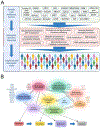Moving beyond amyloid and tau to capture the biological heterogeneity of Alzheimer's disease
- PMID: 37019812
- PMCID: PMC10192069
- DOI: 10.1016/j.tins.2023.03.005
Moving beyond amyloid and tau to capture the biological heterogeneity of Alzheimer's disease
Abstract
Alzheimer's disease (AD) manifests along a spectrum of cognitive deficits and levels of neuropathology. Genetic studies support a heterogeneous disease mechanism, with around 70 associated loci to date, implicating several biological processes that mediate risk for AD. Despite this heterogeneity, most experimental systems for testing new therapeutics are not designed to capture the genetically complex drivers of AD risk. In this review, we first provide an overview of those aspects of AD that are largely stereotyped and those that are heterogeneous, and we review the evidence supporting the concept that different subtypes of AD are important to consider in the design of agents for the prevention and treatment of the disease. We then dive into the multifaceted biological domains implicated to date in AD risk, highlighting studies of the diverse genetic drivers of disease. Finally, we explore recent efforts to identify biological subtypes of AD, with an emphasis on the experimental systems and data sets available to support progress in this area.
Keywords: GWAS; LOAD; RNA splicing; amyloid beta; endosome; genetics; iPSCs; lysosome; mitochondria.
Copyright © 2023 Elsevier Ltd. All rights reserved.
Conflict of interest statement
Declaration of interests D.J.S. is a director and consultant to Prothena Biosciences and an ad hoc advisor to Eisai and Roche. T.L.Y-P. is a member of the AMP-AD consortium and collaborates with industry partners within the context of AMP-AD.
Figures




References
-
- Schneider JA, et al. , Mixed brain pathologies account for most dementia cases in community-dwelling older persons. Neurology, 2007. 69(24): p. 2197–204. - PubMed
Publication types
MeSH terms
Substances
Grants and funding
LinkOut - more resources
Full Text Sources
Medical

